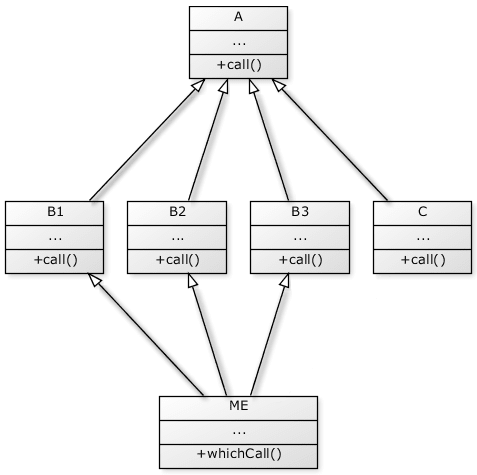A solution to the “diamond problem” in Python
The diamond problem, as depicted in the UML-diagram, is a simple ambiguity problem, raised if a specific feature “call()” is implemented in more than one superclass.

If an object of class ME would like to call “call()” which one does it call, is it the right one, and if not, how to fix this???
A simple source code example is presented below:
class A:
def call(self):
pass
class B1(A):
def call(self):
print "I am parent B1"
class B2(A):
def call(self):
print "I am parent B2"
class B3(A):
def call(self):
print "I am parent B3"
class C(A):
def call(self):
print "I (C) was not invited"
class ME(B2, B1, B3):
def whichCall(self):
print self.call()
def restructure(self, parent1, parent2, parent3):
self.__class__.__bases__ = (parent1, parent2, parent3, )
def printBaseClasses(self):
print self.__class__.__bases__The ordering of base classes defines the order of search, for an implementation of method “call()”. Compare with the following example:
me = ME()
me.printBaseClasses()
# result > (<class __main__.B2 at 0x8b1c02c>, <class __main__.B1 at 0x8b1c62c>, <class __main__.B3 at 0x8b1c05c>)
me.whichCall()
# result > I am parent B2Python allows us easily to change the order of base classes during runtime, and thus also the search order for the right method:
me.restructure(B1, B3, B2)
me.printBaseClasses()
# result > (<class __main__.B1 at 0xa27f62c>, <class __main__.B3 at 0xa27f05c>, <class __main__.B2 at 0xa27f02c>)
me.whichCall()
# result > I am parent B1But Python allows even more. It is also possible to add parent classes (as class C), which was originally not defined as a parental class:
me.restructure(C, B3, B2)
me.printBaseClasses()
# result > (<class __main__.C at 0xa27f08c>, <class __main__.B3 at 0xa27f05c>, <class __main__.B2 at 0xa27f02c>
me.whichCall()
# result > I (C) was not invitedUse it wisely 😉
